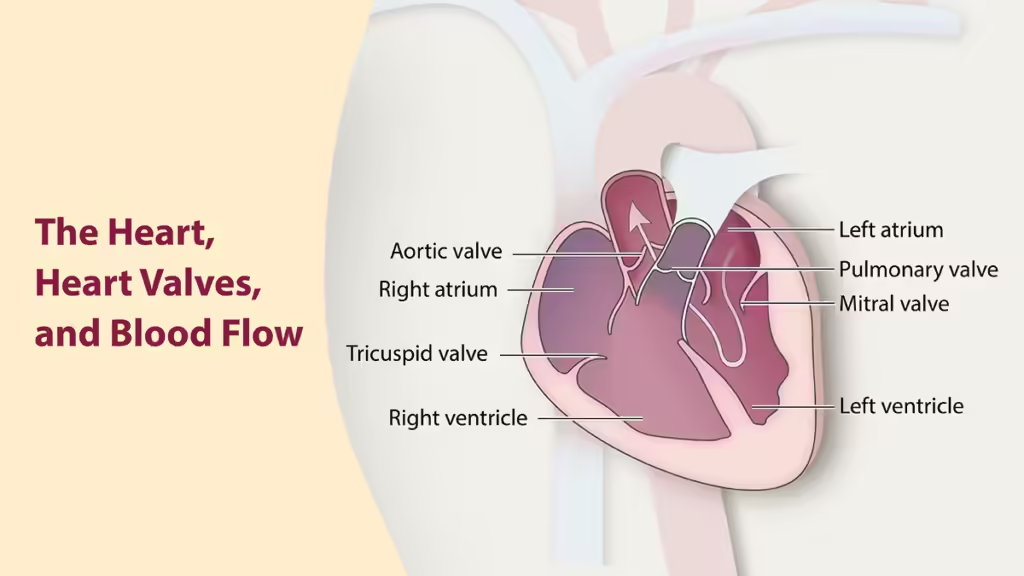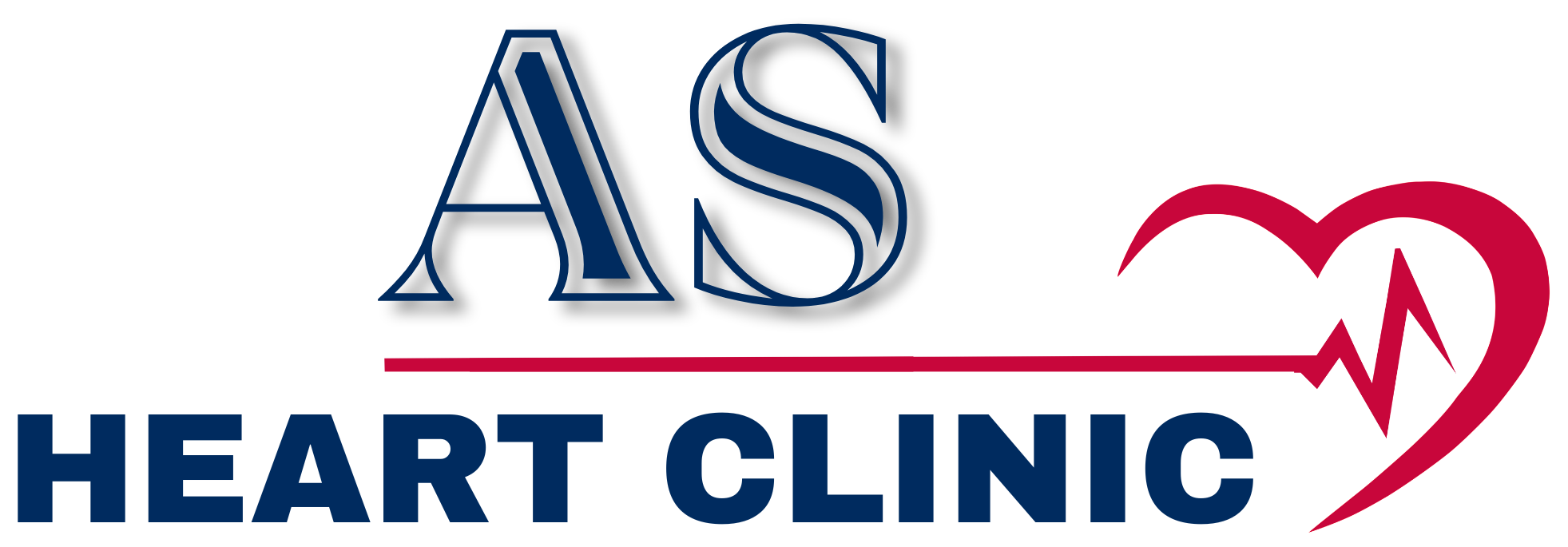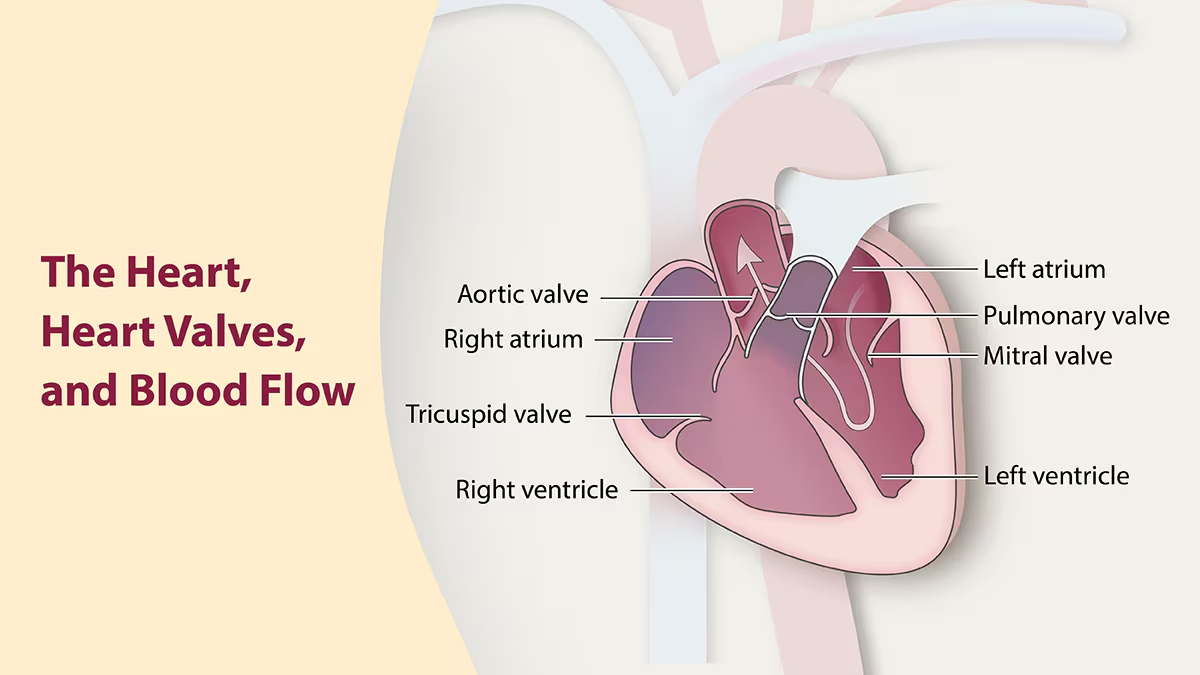Valvular Heart Disease
Valvular heart disease occurs when one or more of the heart’s valves do not function properly, disrupting normal blood flow. The heart has four valves—mitral, aortic, tricuspid, and pulmonary—that regulate blood flow through the heart’s chambers. When a valve doesn’t open or close properly, it can lead to blood flow problems, which may strain the heart and lead to serious complications such as heart failure, arrhythmias, or stroke.

Types of Valvular Heart Disease:
Aortic Valve Disease:
- Aortic Stenosis: The aortic valve narrows, preventing blood from flowing freely from the heart to the rest of the body.
- Causes: Age-related calcification, congenital defects (bicuspid aortic valve), or rheumatic fever.
- Symptoms: Chest pain, shortness of breath, fatigue, dizziness, and fainting.
- Treatment Options: Medications for symptom management, aortic valve replacement (surgical or transcatheter), balloon valvuloplasty.
- Aortic Regurgitation: The aortic valve does not close properly, causing blood to leak back into the left ventricle.
- Causes: High blood pressure, infections, congenital heart defects, or age-related degeneration.
- Symptoms: Shortness of breath, chest pain, fatigue, palpitations, and swollen ankles.
- Treatment Options: Medications, lifestyle changes, and valve replacement surgery.
- Aortic Stenosis: The aortic valve narrows, preventing blood from flowing freely from the heart to the rest of the body.
Mitral Valve Disease:
- Mitral Stenosis: The mitral valve becomes narrowed, restricting blood flow from the left atrium to the left ventricle.
- Causes: Rheumatic fever, congenital defects, or calcium buildup.
- Symptoms: Shortness of breath, fatigue, swollen feet or ankles, heart palpitations, and chest discomfort.
- Treatment Options: Medications, balloon valvuloplasty, or mitral valve repair/replacement surgery.
- Mitral Regurgitation: The mitral valve doesn’t close completely, allowing blood to flow backward into the left atrium.
- Causes: Mitral valve prolapse, heart attack, infections, or heart enlargement.
- Symptoms: Shortness of breath, fatigue, irregular heartbeat, and swelling in the legs or feet.
- Treatment Options: Medications to relieve symptoms, mitral valve repair or replacement surgery.
- Mitral Stenosis: The mitral valve becomes narrowed, restricting blood flow from the left atrium to the left ventricle.
Tricuspid Valve Disease:
- Tricuspid Stenosis: The tricuspid valve narrows, limiting blood flow from the right atrium to the right ventricle.
- Causes: Rheumatic fever or congenital abnormalities.
- Symptoms: Swelling in the legs and abdomen, fatigue, and irregular heartbeats.
- Treatment Options: Medications for symptom relief, valve repair, or replacement surgery.
- Tricuspid Regurgitation: The tricuspid valve does not close properly, causing blood to leak back into the right atrium.
- Causes: Pulmonary hypertension, heart failure, or congenital defects.
- Symptoms: Fatigue, swelling in the legs or abdomen, and heart palpitations.
- Treatment Options: Medications, surgical valve repair, or replacement.
- Tricuspid Stenosis: The tricuspid valve narrows, limiting blood flow from the right atrium to the right ventricle.
Pulmonary Valve Disease:
- Pulmonary Stenosis: The pulmonary valve is narrowed, reducing blood flow from the right ventricle to the lungs.
- Causes: Congenital heart defects or infections.
- Symptoms: Shortness of breath, chest pain, fatigue, and heart palpitations.
- Treatment Options: Balloon valvuloplasty, valve repair, or replacement surgery.
- Pulmonary Regurgitation: The pulmonary valve does not close properly, causing blood to flow backward into the right ventricle.
- Causes: Pulmonary hypertension, congenital heart defects, or damage from prior surgeries.
- Symptoms: Shortness of breath, fatigue, chest pain, and fluid retention.
- Treatment Options: Valve repair or replacement surgery.
- Pulmonary Stenosis: The pulmonary valve is narrowed, reducing blood flow from the right ventricle to the lungs.
Causes of Valvular Heart Disease:
- Age-Related Degeneration: Over time, heart valves can become calcified or weakened, leading to stenosis or regurgitation.
- Congenital Heart Defects: Some people are born with abnormal valves (e.g., bicuspid aortic valve), which may lead to valvular disease later in life.
- Rheumatic Fever: An infection caused by untreated strep throat, which can damage heart valves and lead to rheumatic heart disease.
- Infective Endocarditis: A bacterial infection that can damage heart valves.
- Heart Attack: Damage to the heart muscle can affect valve function, particularly the mitral valve.
- Autoimmune Diseases: Conditions like lupus or rheumatoid arthritis can damage heart valves.
Symptoms of Valvular Heart Disease:
- Shortness of Breath: Especially during physical activity or when lying flat.
- Fatigue: Feeling unusually tired even with minimal exertion.
- Chest Pain or Discomfort: May be associated with aortic or mitral valve disease.
- Heart Palpitations: Feeling of an irregular, racing, or skipping heartbeat.
- Swelling (Edema): Particularly in the ankles, feet, legs, or abdomen.
- Dizziness or Fainting: Can occur due to reduced blood flow through the narrowed valves.
- Rapid Weight Gain: Often due to fluid retention caused by heart failure.
Diagnosis of Valvular Heart Disease:
- Physical Examination: A doctor may detect a heart murmur, which can indicate a valve problem.
- Echocardiogram: An ultrasound of the heart that shows how well the heart valves are functioning.
- Electrocardiogram (ECG): Measures the electrical activity of the heart and can detect enlargement or stress on the heart.
- Chest X-ray: Can show heart enlargement or fluid buildup in the lungs.
- Cardiac MRI or CT Scan: Provides detailed images of the heart’s structure and valve function.
- Cardiac Catheterization: A procedure that measures the pressure in the heart chambers and evaluates blood flow through the heart valves.
Treatment of Valvular Heart Disease:
Lifestyle Modifications:
- Healthy Diet: A heart-healthy diet low in sodium and unhealthy fats can help reduce the strain on the heart.
- Exercise: Light to moderate physical activity can help strengthen the heart, but it should be guided by a healthcare provider.
- Weight Management: Maintaining a healthy weight can reduce the heart’s workload.
- Smoking Cessation: Smoking increases the risk of heart valve damage and worsens symptoms.
- Limit Alcohol and Caffeine: Reducing these substances can help prevent arrhythmias associated with valvular disease.
Medications:
- Diuretics: Help reduce fluid buildup in the lungs or body.
- ACE Inhibitors or ARBs: Lower blood pressure and reduce strain on the heart.
- Beta-Blockers: Slow the heart rate and improve blood flow.
- Anticoagulants (Blood Thinners): Prevent blood clots in patients with valve problems, especially in those with mechanical valves.
- Antiarrhythmics: Help control irregular heartbeats caused by valvular dysfunction.
Surgical Options:
- Valve Repair: In some cases, the valve can be repaired without needing to be replaced. This is often done for mitral or tricuspid valve disease.
- Valve Replacement:
- Mechanical Valves: Made of durable materials, mechanical valves last longer but require lifelong blood thinners to prevent clots.
- Bioprosthetic (Tissue) Valves: Made from animal tissue or donated human valves, they don’t require blood thinners but may need to be replaced after 10-20 years.
- Transcatheter Aortic Valve Replacement (TAVR): A minimally invasive procedure used to replace a narrowed aortic valve without open-heart surgery.
- Balloon Valvuloplasty: A procedure used to widen a narrowed valve, often used for pulmonary or mitral stenosis.
Monitoring and Regular Check-Ups:
- Regular monitoring through echocardiograms and other tests can track disease progression and determine if and when surgery is necessary.
Prevention of Valvular Heart Disease:
- Prevent Rheumatic Fever: Treat strep throat infections promptly to prevent rheumatic fever and its impact on the heart valves.
- Manage Risk Factors: Controlling high blood pressure, high cholesterol, and diabetes can help reduce the risk of developing valve disease.
- Avoid Smoking: Smoking increases the risk of valve degeneration.
- Prevent Infections: Practice good dental hygiene and treat infections promptly to reduce the risk of infective endocarditis.
Prognosis:
The prognosis for valvular heart disease depends on the severity of the condition, how early it is diagnosed, and the effectiveness of treatment. Many people with mild to moderate valvular disease live normal lives with medications and lifestyle changes. However, severe valve disease may require surgical intervention to improve quality of life and reduce complications like heart failure or stroke. Regular follow-up with a healthcare provider is crucial to monitor disease progression and make timely treatment decisions.

